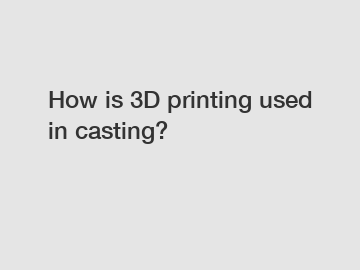How is 3D printing used in casting?
How is 3D printing used in casting?
The use of 3D printing in casting has revolutionized the manufacturing industry. As an additive manufacturing process, 3D printing allows for the creation of intricate and complex designs that were previously impossible to produce using traditional casting methods. This technology has revolutionized the way in which products are developed and manufactured, offering increased efficiency, cost-effectiveness, and customization options.
The process begins with the creation of a digital 3D model using CAD software. This model is then converted into a format that is compatible with 3D printers. The printer uses this digital model as a guide to deposit precise layers of material, typically a thermoplastic or metal, to build up the final object. This layer-by-layer approach allows for the creation of highly detailed and accurate components, even those with intricate internal structures.

One of the key advantages of using 3D printing in casting is the ability to create complex and customized molds. Traditional casting methods often require the production of complex tooling and molds, which can be time-consuming and expensive. With 3D printing, however, the mold can be easily generated directly from the digital model, eliminating the need for tooling.
Additionally, 3D printing in casting allows for the production of lightweight yet strong components. By using advanced materials and optimizing the internal structure of the object, engineers can achieve a higher strength-to-weight ratio compared to traditionally casted components. This is particularly beneficial in industries such as aerospace and automotive, where weight reduction is a critical factor.
Furthermore, the use of 3D printing in casting significantly reduces lead times. The traditional casting process often involves numerous steps, including mold creation, wax patterns, and metal pouring. Each of these steps can take considerable time and require skilled labor. With 3D printing, however, the entire casting process can be streamlined and automated, reducing lead times from weeks to days.
The impact of 3D printing in casting extends beyond just the manufacturing process. It also offers substantial cost savings. Traditional casting methods require the production of molds and tooling, which can be costly, especially for small batch productions. With 3D printing, molds can be produced quickly and at a fraction of the cost, making it feasible and cost-effective to manufacture small quantities or even one-off customized components.
In conclusion, 3D printing has revolutionized the field of casting by enabling the production of intricate and complex designs, reducing lead times, offering cost savings, and providing customization options. The ability to create complex molds directly from digital models, produce lightweight yet strong components, and accelerate the manufacturing process has transformed the industry. As the technology continues to evolve and become more affordable, we can expect to see even greater adoption of 3D printing in casting, further pushing the boundaries of what is possible in manufacturing.
For more information, please visit vacuum casting service, quick turn cnc, airplane parts rapid mold tools.

Comments
0